
The blue-headed fantail is a fantail endemic to the northern Philippines where it is found on the islands of Luzon and Catanduanes. Until recently, it was considered conspecific with the Tablas fantail and Visayan fantail.

Eversmann's redstart, also known as the rufous-backed redstart, is a passerine bird belonging to the genus Phoenicurus. It was formerly classified in the thrush family Turdidae but is now placed in the Old World flycatcher family Muscicapidae. It was described by the German biologist Eduard Friedrich Eversmann who is commemorated in the bird's English name.

The blue-capped kingfisher, also known as Hombron's kingfisher, is a species of bird in the family Alcedinidae endemic to the Philippines and found only on Mindanao. It is one of the most colorful kingfishers in the country having a dark blue cap and wings with rufous spots, a striped rufous belly, white chin and red bill. Its natural habitats are on the upper ranges of tropical moist lowland forest and tropical moist montane forests. It is threatened by habitat loss.
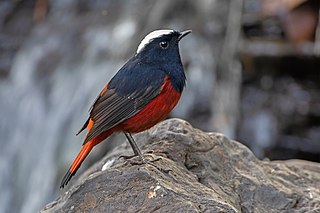
The white-capped redstart or white-capped water redstart is a passerine bird of the Old World flycatcher family Muscicapidae native to the Indian Subcontinent,Southeast Asia, much of China, and to certain regions of Central Asia.

The blue-breasted blue flycatcher, also known as the blue-breasted flycatcher, is a species of bird in the family Muscicapidae. It is endemic to the Philippines found only north and central parts of Luzon. Its natural habitat is tropical moist lowland forests. The Rufous-breasted blue flycatcher was formerly considered to be a subspecies.

The Palawan blue flycatcher is a species of bird in the family Muscicapidae. It is endemic to the Philippines found only on Palawan and its surrounding islands.
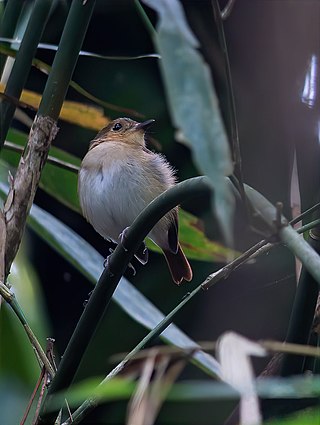
The cryptic flycatcher is a species of bird in the family Muscicapidae. It is endemic to the Philippines only being found in the island of Mindanao. Its natural habitat is tropical moist mid-montane forests from 600 - 1,500 meters.
The furtive flycatcher is a species of bird in the family Muscicapidae. It is endemic to the Philippines found only on the island of Luzon.
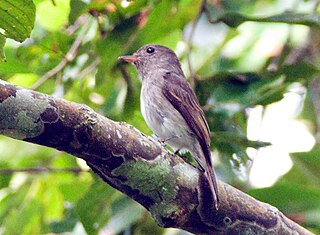
The ashy-breasted flycatcher is a species of bird in the family Muscicapidae. It is endemic to the Philippines found only on the islands of Negros and Luzon. Its natural habitat is tropical moist lowland forests where it rarely observed. It is threatened by habitat loss.

The green-backed whistler or olive-backed whistler, is a species of bird in the family Pachycephalidae. It is endemic to the Philippines. Its natural habitats are tropical moist lowland forest and tropical moist montane forest.

Phoenicurus is a genus of passerine birds in the Old World flycatcher family Muscicapidae, native to Europe, Asia and Africa. They are named redstarts from their orange-red tails. They are small insectivores, the males mostly brightly coloured in various combinations of red, blue, white, and black, the females light brown with a red tail. A molecular phylogenetic study published in 2010 led to a reorganization of the Old World flycatchers family in which the two species in Rhyacornis and the single species in Chaimarrornis were merged into Phoenicurus.
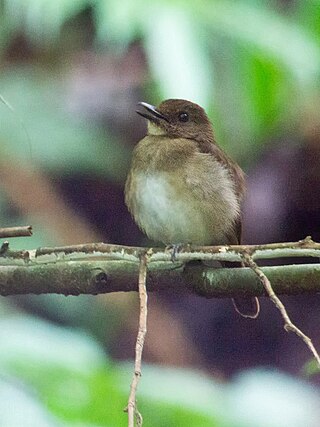
The white-throated jungle flycatcher, also known as the Negros jungle flycatcher is a species of bird in the Old World flycatcher family Muscicapidae. It is endemic to the Philippines and formerly on Guimaras before its extirpation there. The natural habitats of the white-throated jungle flycatcher are tropical moist lowland forests and tropical moist montane forests at altitudes of up to 1,350 meters. It is threatened by habitat loss.
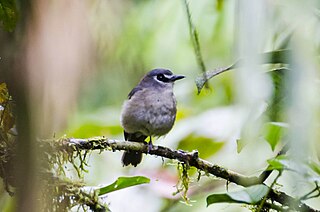
The slaty-backed jungle flycatcher, also known as the Goodfellow's jungle flycatcher or the Mindanao jungle flycatcher is a species of bird in the Old World flycatcher family Muscicapidae. It is endemic to the Philippines found only on the island of Mindanao. The specific epithet honours the British zoological collector Walter Goodfellow. Its natural habitat is tropical moist montane forests. It is threatened by habitat loss

The white-browed jungle flycatcher, also known as the Luzon jungle-flycatcher and the Rusty-flanked jungle-flycatcher, is a species of bird in the Old World flycatcher family Muscicapidae. It is endemic to Luzon island, in the Philippines. The natural habitat of the white-browed jungle flycatcher is tropical moist montane forests of the Cordillera Mountain Range and possibly Sierra Madre Mountains. It is threatened by habitat loss.

The Philippine jungle flycatcher is a species of passerine bird in the Old World flycatcher family Muscicapidae. It is endemic to the Philippines. Its natural habitat is tropical moist lowland forests up to 1,000 meters above sea level.

The plumbeous water redstart is a passerine bird in the Old World flycatcher family Muscicapidae. It is found in South Asia, Southeast Asia and China. Males are slate blue in colour, while females are grey. The bird's common name refers to its colour which resembles lead. They tend to live near fast-moving streams and rivers.

The rufous paradise flycatcher is a species of bird in the family Monarchidae. It is found in Indonesia and the Philippines. Its natural habitat is tropical moist lowland forests.
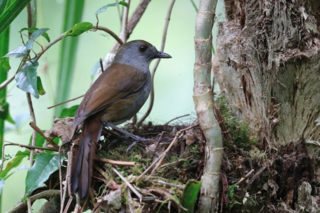
The Bagobo babbler or Bagobo robin is a monotypic species of bird with its taxonomy undergoing numerous changes and is currently classified as Muscicapidae or an old world flycatcher. It is endemic to the Philippines only found in Mindanao. It was once deemed "unquestionably the Philippines most secretive bird" by ornithologist Robert Kennedy. It habitat are in moist montane forests up to 2,030 meters above sea level. It is named after the Bagobo tribe.
The Sulu jungle flycatcher is a species of passerine bird in the Old World flycatcher family Muscicapidae. It is endemic to the Sulu Archipelago. Its natural habitat is tropical moist montane forests. While it has yet to be assessed by the International Union for Conservation of Nature, this species is likely threatened by habitat loss.
The rufous-breasted blue flycatcher is a species of bird in the family Muscicapidae. It is endemic to the Philippines found on the Bicol Peninsula and Catanduanes. Its natural habitat is tropical moist lowland forests. It was formerly treated as a subspecies of the blue-breasted blue flycatcher. It is one of the most mysterious and least observed species with no known photos of any living bird.


















